| THE FALL OF CHRONOPOLIS |
|
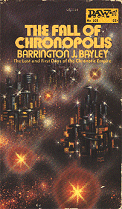
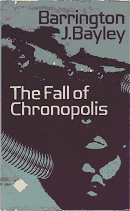
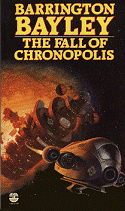
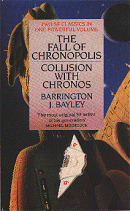
|
DAW 451-UQ1114, 1974, cover art by Kelly Freas Cosmo, 1976 (Italy) as "La caduta di Cronopolis" Allison & Busby, 1979, cover by Richard Hollis Fontana, 1980, cover art Chris Foss Pan, 1989, omnibus edition with COLLISION WITH CHRONOS, cover art by Chris Moore |
There is real time... and there is potential time.
By controlling the difference, the Chronotic Empire came into existence
and maintained itself over a thousand years of human history. Its Time
Fleets, armadas of time-travelling fortresses, patrolled its temporal
borders relentlessly, blotting out potential-time deviations, erasing
errors of history that might undermine the empire.
But nevertheless the empire's days were numbered, for somewhere in its
own future was the century of the Hegemony, its implaccable enemy.
Barrington J. Bayley, author of COLLISION COURSE, once again demonstrates
in this brilliantly different novel, his ability to weave unusual concepts
of time with the human problems of the men and women caught up in the
contradictions of a destiny no mortal could ever comprehend.
"Spectacular" - Encyclopedia of Science Fiction
"Recommended, for its gorgeous campness as well as its ideas." - Andy Robertson, Interzone
"An enjoyable time-and-space opera with philosophical overtones." - David Pringle
"Probably the most fully realized time paradox space opera from his pen.." - John Clute
"The Fall of Chronopolis roasts all the chestnuts in a monumental hearth; causal loops abound, sub-plots are allowed to swallow their own tales, futures impinge on presents and pasts cavort with elsewheres. Bayley, however, employs a wealth of such devices, meshing them together so tightly that, while they may not seem fresh, they still startle." - Rhys Hughes
In a way this book is a fable. We have technology acting as magic. We have the empire (even if it is technically advanced), which is ruled by a king and his magician, the insane computer. We have our hero, the knight of these strange, new limits, who is unjustly cursed and sentenced for something he didn't do. There is the princess he must rescue. He even gets to fight the dragon and the mad warlord. All in the currents of space and time.
Even though this is a "literary" novel, it is also weaved inside an extremely rousing and charged adventure. If you are so inclined, you can read this as just entertainment and be thrilled by the plot twists and the sense-of-wonder. But if you are looking for something more, you can find that here also. Philosophy and cosmology, wonders of the universe, as entertainment. And this IS great entertainment. Brimming with theories and ideas." 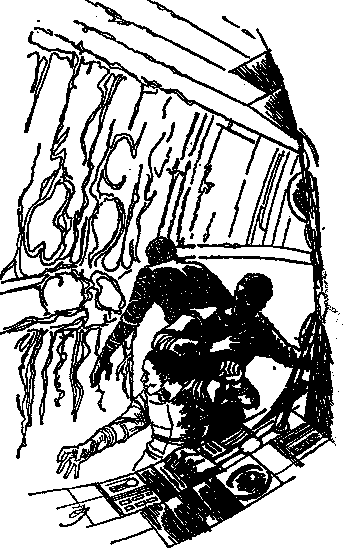 "Bayley writes here about subjects like eternal recurrence, time-theory, religious crusades and racism in the context of a traditional pulp space-opera. The parallels that these strange, yet plausibly mad religious empires have with our history are startling when viewed at first from a point of view which the reader thinks we are supposed to feel sympathy for. The core repeats many of Bayley's recurring themes and characters, from the wise scientist to the disastrous effects of a single idea finding freedom of expression inside a structure; be it a society or a man. Out of chaos something new is formed. We can only hope it is more sane than before.
"Bayley writes here about subjects like eternal recurrence, time-theory, religious crusades and racism in the context of a traditional pulp space-opera. The parallels that these strange, yet plausibly mad religious empires have with our history are startling when viewed at first from a point of view which the reader thinks we are supposed to feel sympathy for. The core repeats many of Bayley's recurring themes and characters, from the wise scientist to the disastrous effects of a single idea finding freedom of expression inside a structure; be it a society or a man. Out of chaos something new is formed. We can only hope it is more sane than before.
| Barrington Bayley: "The notion of the void was a huge puzzle to the ancient Greeks. Was it non-existence, or could it exist? Despite the impressive-seeming descriptions of general relativity and quantum mechanics, I think it's just as puzzling today. What is the relation of space to matter? Which has primacy?" |

